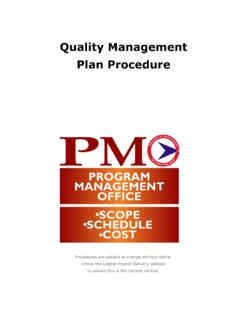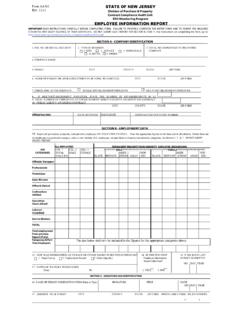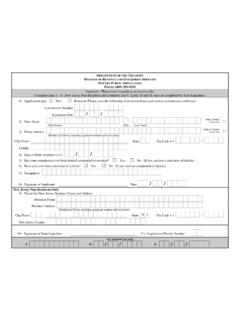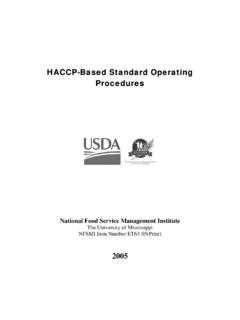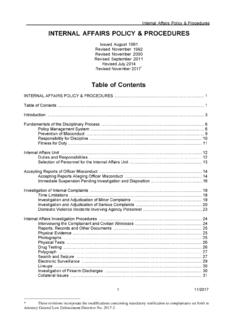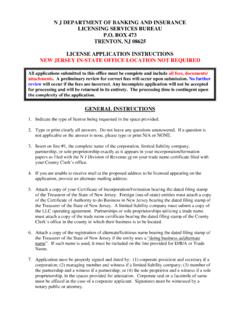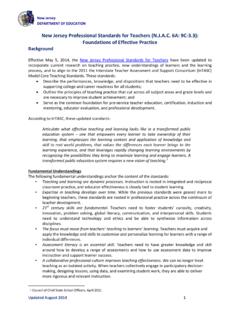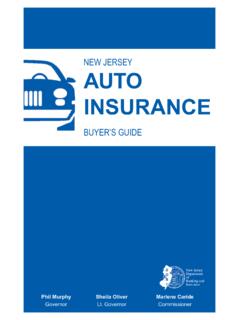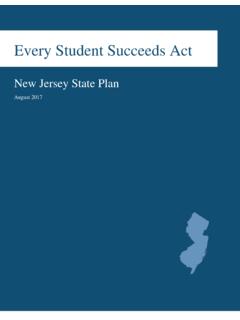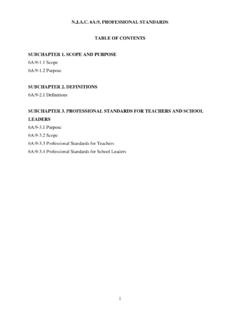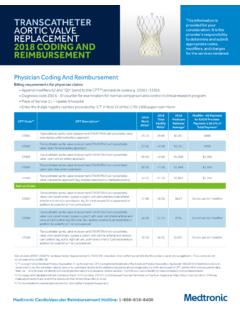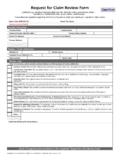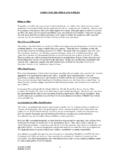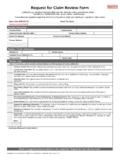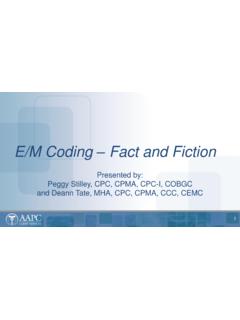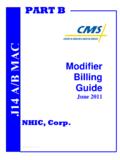Transcription of Hot Mix Asphalts 101 - New Jersey
1 Hot Mix asphalt 101 Definition of HMAIn simple :A mixture of asphalt binder and graded mineral aggregate, mixed at an elevated temperature and compacted to form a relatively dense pavement layer( 5% binder and 95% aggregate)HMA Uses Highways Airfields Port Facilities Parking Lots Recreational (Bikeways, Tennis Courts, Tracks) Hydraulic Structures Recycled MaterialComponents asphalt Binder Mineral Aggregate Air Optional modifiers /Additives: Binder modifiers /Additives ( , polymers, elastomers, fibers, rubber) Aggregate modifiers /Additives ( , lime, granulated rubber, anti-strip agents)Components (cont.)MineralaggregateAsphalt binderAir voidAir voidComponents (cont.)Total VolumeAir 2-20% asphalt binder 3-8%Absorbed asphalt binder <1% Mineral aggregate 85-95%NOTE: relative size of rectangles indicate approximate proportions of components in the of HMA Mixtures Dense-Graded (DGA) Size evenly distributed from smallest to largest size (well-graded) Open-Graded (or Uniformly-Graded) Friction Course (OGFC) Primarily coarse aggregate with few fines Stone Mastic (Matrix) asphalt (SMA) Mid-size aggregate missing or reducedStone Matrix AsphaltOpen Graded Friction CourseDense MixHot Mix AsphaltMixture Design ObjectivesSpecific Mix Design Objectives Stability (permanent deformation resistance) Durability Moisture damage and aging Fatigue cracking resistance Safety (adequate skid resistance)
2 Resistance to thermal cracking Permeability FlexibilityMix Design ConsiderationsMixture Property Component and Construction Effects on Mixture Properties asphalt Stiffness Aggregate Gradation asphalt Content Degree of CompactionHard Soft DenseOpen High Low High Stability X X X High Durability - - X X High Fatigue Resistance X X X High Skid Resistance X - X - Fracture Strength X X X High Imperviousness - - X X High Basic Mix Design PhilosophyAsphalt binder content As much asphalt as possible for Durability Fatigue resistance Flexibility Not so much asphalt to affect Stability FrictionAsphalt Content (% AC)
3 Rutting and Bleeding PotentialDurability and Cracking PotentialAsphalt Content Impact on HMA Performance Balancing ActConsideration of Structural Composition on Mix DesignTop 1/31 Stability2 Skid Resistance3 Durability4 Tensile Strength -Thermal CrackingMiddle 1/31 Stability 2 DurabilityBottom 1/31 Fatigue Resistance2 DurabilitySuperpave Mixture DesignSuperior Performing asphalt Pavements1. Materials Selection2. Design Aggregate Structure3. Design Binder Content4. Moisture SensitivityTSRTSR4 Steps of Superpave Mix DesignAggregate Properties Consensus Properties -required coarse aggregate angularity (CAA) fine aggregate angularity (FAA) flat, elongated particles clay content Source Properties -agency option toughness soundness deleterious materialsAsphalt BindersPolymer Modified Binders Ideal asphalt Binder Low stiffness at construction temperature High stiffness at high in-service temperature Low stiffness at low in-service temperature Excellent long-term durabilitySources of asphalt Binder asphalt occurs naturally or is obtained through distillation of petroleum crude oil.
4 Examples of natural asphalt include the binder in rock asphalt and Trinidad Lake asphalt . More commonly, asphalt is obtained through distillation of crude Atmospheric DistillationVaporNaphthaKeroseneGas OilResiduumDecreasing Molecular WeightPropane & ButaneFeedstock for gasolineAviation/domestic fuelFeedstock for dieselLubrication oilsFeedstock for asphalt binder productionIncreasing Value ($)Bottom of the BarrelPolymer-Modified Binders The term polymer refers to a large molecule formed by chemically reacting many ( poly ) smaller molecules (monomers) to one another in long chains or clusters. Physical properties of a specific polymer are determined by the sequence and chemical structure of the monomers from which it is Polymer-Modified asphalt ?discrete polymer particlespolymer strands developingcontinue polymer strands developingmore uniform dispersion almost cross-linked188oC 2h200oC 2h188oC4h200oC 4hVenezuelan binder modified with 7% EVA, cracked surface, x mm.
5 Wegan and Brul , AAPT, produced from the modified Venezuelan binder, x mm. Wegan and Brul , AAPT, produced from the modified Venezuelan binder, x mm. Wegan and Brul , AAPT, HMA produced from the modified Venezuelan binder, x mm. Wegan and Brul , AAPT, m20 mAggregateAggregatePolymer PhasePolymer PhaseAggregateAggregateAggregateAggregat ePolymer PhasePolymer PhaseMiddle East binder modified with 7% EVA, cracked surface, x mm. Wegan and Brul , AAPT, produced from the modified Middle East binder, x mm. Wegan and Brul , AAPT, PhaseAggregateAggregatePolymer PhaseRubbersPlasticsThermoplastic(Elasto mers)(Plastomers)ThermosettingRubbers and PlasticsDefinitions Thermoplastic materials soften and become plastic-like when heated but return to their hardened state upon cooling.
6 Thermosetting materials flow under stress when heated but, once cooled, cannot be re-softened by Grade is a function of environment and traffic levelEffect of Loading Rate on Binder Selection Example for 55 mph highwayPG 64-22 for 30 mph highwayPG 70-22 for intersectionsPG 76-22NJ Standard GradeNJ Standard GradeSlow Slow --BumpBumpone gradeone gradeStopped Stopped --BumpBumptwo gradestwo gradesGrading System for asphalt BindersCompaction level is a function of traffic and depth of layerMix size is determined by thickness of layer( 4 times Designation Name)2) Compaction LevelLowMediumHighHMA H 64 Surface Course3) Binder Grade4) Location within the payment1) Nominal MaximumAggregate Size (mm)2) Compaction LevelLowMediumHighHMA 19M64 Base Course3) Binder Grade4) Location within the payment1) Nominal MaximumAggregate Size (mm)Superpave Mix Graded Mixes Ideal HMA Mixture Resistant to permanent deformation Resistant to fatigue cracking Impermeable Workable Flexible Good surface size raised to the power of passingDense-Graded MixturesDense-Graded Mixtures Design procedure follows AASHTO R35 Used extensively in the Binder content: typically to 6% Field compacted air void content: typically 6 to 8%Dense-Graded Mixtures: Advantages Good interlock of aggregate particles if compacted well Relatively low permeability if compacted well Strength and stiffness derived from binder and aggregate structure In NJ, generally a stiff mix Cheaper than other asphalt mixture types Less asphalt binder, RAPD ense-Graded Mixtures.
7 Disadvantages Selection of optimum binder content: Need enough binder for good durability and cracking BUT Not too much binder for good permanent deformation resistance Optimum asphalt binder content generally results in relatively thin binder film thickness Air void content and permeability are not optimum for moisture damage resistance Design for 4% AV, generally placed between 6 to 8%Open Graded Friction size raised to the power of passingOpen-Graded MixturesOpen-Graded Mixtures: Advantages High permeability High asphalt binder contents resulting in thick binder films Lower noise generated by tires as compared with dense-graded mixtures Porous nature allows for surface water to drain off surface Reduces splash and spray Best applied in areas of faster, continuous traffic with minimal sharp turnsOpen-Graded Mixtures.
8 Disadvantages Aggregate interlock is shape dependent (generally poor) Lower strength and stiffness Higher costs associated with polymer-modified binders, higher asphalt content and fibers Typically requires additional de-icing applications to maintain ice free in cold regions Recommended not to be used in areas of high, shear turning and slow moving traffic High, shear turning may cause shoving-type failures Slow moving traffic may clog porous structureWet Weather Accidents - TxDOTYear2001 2002 20032004% ChangeTotal # Weather Weather Injuries2516210-100 Annual Rainfall (in) Rain OGFC AfterReduction in Splash and SprayNot Overlaid YetReduced Pavement-Related NoiseSurface TypedB(A) mm mm mm Matrix (Mastic) size raised to the power of passingStone Mastic (Matrix) asphalt (SMA) or Gap-Graded MixturesSMA Mixtures Used as a wearing course ( , SMA) Mix design methods: AASHTO R46-08, Designing Stone Matrix asphalt (SMA) Some states have variations of AASHTO R46 Binder content: typically 5 to 7% Polymer-modified binder and fibers used to minimize draindown Compacted air void content: typically 6 to 8%SMA Materials Usually use locally available aggregates: Cubical and tough Modified (lime, antistrip liquids) Usually use locally available binders.
9 ModifiedSMA Advantages Good aggregate interlock Low permeability Strength and stiffness derived from binder and aggregate structure Relatively high binder contents provide good durability Best used in areas of heavy traffic where rutting and fatigue cracking are concernsSMA Disadvantages asphalt suppliers not accustomed to producing some growing pains Additional time and effort in material production Aggregates! Typically use a modified binder (higher cost) Costs typically prohibit use in normal traffic areasDesigning with asphalt RubberAsphalt Rubber Applications asphalt rubber is the process of adding recycled, crumb rubber to hot mix asphalt (called dry process) or the asphalt binder (called wet process) to modify the final mixture Difficult to use in dense-graded mixtures due to residual crumb rubber Best used in gap-graded type mixtures (SMA and OGFC)Why Put Tire Rubber in asphalt ?
10 Tire rubber is an engineering tool to: Reduce cracking Naturally increase asphalt content and asphalt film thickness (providing an increase in durability) High asphalt binder viscosity prevents bleeding, flushing and drain-down asphalt enhancement due to rubber increases both the high and low temperature performance Limited research has shown the addition of rubber also reduces pavement-related noiseAR-OGFC Uses Approximately 1000 Tires Per Lane-MileWhat Defines asphalt Rubber?ASTM D6114 asphalt rubber is a blend of asphalt cement, reclaimed tire rubber and certain additives, in which the rubber component is at least 15% by weight of the total blend and has reacted in the hot asphalt cement sufficiently to cause swelling of the rubber particles Swelling of Crumb RubberElectron-microscope: Immediately after mixing (dry process)Swelling of Crumb Rubber (cont.)
